General
Wednesdays with Wade: Donald Duck’s Other Daddy (PART ONE)
Wade Sampson begins a special two part series about Disney animation legend Jack Hannah

I was recently watching the Disney Treasures DVD: “The Chronological Donald Duck” and once again I marvelled at Jack Hannah’s handling of the the character. In the old days, fans used to confuse Jack with William Hanna of Hanna-Barbera fame and Jack always laughed when someone complimented him on his creation of Yogi Bear or Scooby-Doo.
Jack Hannah was never interested in self-promotion. As a result, his numerous achievements as an animator, storyman, director and teacher went largely unrecognized by the general public who, whether they realized it or not, had been touched by his craftsmanship. When he died in June 1994, only his peers and a handful of animation historians seemed aware of his passing.
Hannah was labeled by his friend and biographer, Disney historian Jim Korkis, as “Donald Duck’s Other Daddy”. While Hannah did not create the character of Donald Duck, he worked first as animator on the early Donald Duck cartoons, then as a storyman on some of Donald’s most memorable adventures in the 1940s and eventually as a director on the Donald Duck cartoons that received Academy Award nominations. In addition, he directed many of the early Disneyland television shows featuring the quarrelsome quacker teamed up with a live-action Walt Disney, and along with Carl Barks, Hannah was responsible for the first novel-length Donald Duck comic book story, “Pirate’s Gold”. Certainly, Hannah touched almost every area of Donald’s life and influenced his popularity.
John Frederick (Jack) Hannah was born in Nogales, Arizona on January 5, 1913. After high school, he moved to Los Angeles to take an art course at the Art Guild Academy in 1931. His first art related jobs were designing movie posters for Foster and Kleiser as well as for Hollywood Theaters.
“I started out as a poster designer in the middle of the Depression and then I just grabbed any job that came along,” recalled Hannah, “I was trying to get work in the commercial art field when I went into this one art agency with my portfolio. The guy reviewing my work suggested I apply to Disney Studios because they were looking for young fellows with some talent. I told him that I was a commercial artist and not a cartoonist. I went out to the Hyperion Studio anyway with my portfolio and a little fear in my heart. After about a week, I was called by Ben Sharpsteen, who at that time was in charge of reviewing new talent and he asked me to come in for a two week tryout. The two weeks ended up as thirty years of work at Disney.”
Hannah joined the studio in 1933 as an inbetweener.
“When I started the going rate was sixteen dollars a week but Walt had an incentive plan. You were under contract but about quarterly you’d get a two dollar raise. So if you really applied yourself you could move up to a first assistant like I did. I eventually got to assist such outstanding animators as Norm Ferguson, *** Huemer, Les Clark and *** Lundy. The first scenes I animated were in ‘Shanghaied’ (1934) where Mickey duels with Pete using a swordfish. In ‘The Band Concert’ (12935) I animated that bit where during the storm, the benches run away. I did a lot of clean up on the dwarfs in ‘Snow White and the Seven Dwarfs'(1937) or Bill Tytla and in ‘The Old Mill’ (1937), I animated the sequence where a series of bats woke up, yawned and flew out. My first official credit as a full animator was on ‘Mickey’s Circus’ (1936). Within three years, I had become an animator even though I knew that I was never going to be a top one. I consider my work during this period as ‘in the middle’. I didn’t knock them dead with my animation but they always seemed pleased with my work. I then got assigned to Jack King, whose unit was doing a new series of cartoons starring Donald Duck.”
However with the success of “Snow White”, the Disney Studio decided to do some reorganizing. Some of the solid but unexciting animators would be moved aside and replaced with new talent that was being recruited by the studio for future features. Hannah feared he would lose his job but fortunately, he had been making extra money at the studio by submitting gags for various cartoons. Disney would pay up to five dollars for a gag used in a cartoon and Hannah was submitting gag ideas for quite some time.
Harry Reeves, then the head of the story department, suggested he become a storyman. Hannah made the transition and after a short period where he missed the animating part he became excited over the possibilities of doing stories. At first, he rotated around two or three different story crews. When the Studio moved to Burbank, he was teamed with Carl Barks and the two men became the exclusive story team for Jack King and his Donald Duck cartoons. The team of Barks and Hannah were responsible for many memorable Donald Duck cartoons including ‘The Autograph Hound’ (1939, ‘Donald’s Vacation’ (1940), ‘Truant Officer Donald’ (1941 nominated for an Academy Award), ‘Donald Gets Drafted’ (1942) and ‘The Plastics Inventor’ (1944).
“Carl and I got along fine even though he was older and maybe was more grown up than I. When we weren’t working on a story, I’d spend my time down in the new commissary having a Coke and checking out the cute little waitresses. Carl was a real workhorse. He’d still be back at his desk working away. He was always a bit of a loner, but not in an unfriendly way. I learned a lot from him. He was more than just a ‘gag’ type of storyman. He seemed more interested in the overall theme of the story and making sure the gags helped develop the story and weren’t just thrown in for an easy laugh. Carl and I were a story team for awhile so Walt must have thought we were okay. The rule of thumb around the studio was that if you didn’t hear from Walt you were doing fine. I got along well with Walt until I got into directing.”
Yet Hannah and Barks had one grievance with the studio.
“As much as I liked Jack King, he really couldn’t direct personality sequences. This was very irritating to both Carl and me. We saw a lot of potential in the basic ideas we came up with but when they were animated they just fell short because King never fully explored the possibilities.
It was this frustration that made me want to become a director myself,” said Hannah.
Hannah and Barks were approached to illustrate the first all new sixty-four page Donald duck comic book story, entitled “Pirate’s Gold” for Western Publishing. They divided the script, and working nights and weekends, produced a comic book that is now considered one of the most valuable Disney comic books. Barks enjoyed the freedom of working on the comic book more than the teamwork atmosphere of the studio where he would have to submit his work for approval and tinkering by others. When Barks left to do freelance comic book work, Hannah found a new creative outlet for himself.
“The studio was doing a lot of training films. There was a picture that they gave to Jack King about a housewife saving fat for the war effort. I don’t know why they were supposed to save this grease. Maybe it was to make the enemy slip on it? Somebody told me it helped in the making of explosives. King wasn’t interested in the mechanical part of this picture, you know, showing all this stuff going down a funnel. So he gave me a little piece to direct and I just loved it. That was my first little piece of direction and I started to direct more and more. I remember doing most of these films for the Navy like one on the exploder mechanism of the torpedo. This work was very exacting and I had to make several trips to North Island in San Diego and work with the torpedo planes, “said Hannah.
When the war ended, he returned to the story department but now, more than ever, he wanted to direct.
“After the war, I went back to being a storyman but without Carl, I just felt lost. I was told that a young storyman named Bill Berg who later developed into a very good storyman was struggling with a story. Hal Adlequist who was head of the story department asked me to help him out. I filled it with a lot personality bits which I always believed were more important in a story than just gags. I went to Hal and said, ‘I’d just love to direct this. As much as I like Jack King, I can’t see him directing these personality sequences’. I knew I could really do something with this cartoon. Finally after asking repeatedly, the word that came back from Walt implied, ‘Go ahead; let him hang himself.’ I met Walt in the hall one day and he asked how it was going. I replied, ‘Fine, but if I don’t get started on another cartoon I’ll have to put all my costs into this picture and it’s going to run over budget. I need another short to start on while this one is in production.’ I’m certain that Walt looked at that short either at home or in a projection room because he wouldn’t just take my word for it. The next thing I knew, Adlequist told me Walt said it was okay to pick up another one and I ended up directing Disney short cartoons for the next seventeen years!”
TOMORROW: Wade covers Hannah’s impact on Donald Duck, the Disney short he was proudest of directing and his career outside the Disney Studio.
General
Seward Johnson bronzes add a surreal, artistic touch to NYC’s Garment District

Greetings from NYC. Nancy and I drove down from New
Hampshire yesterday because we'll be checking out
Disney Consumer Products' annual Holiday Showcase later today.
Anyway … After checking into our hotel (i.e., The Paul.
Which is located down in NYC's NoMad district), we decided to grab some dinner.
Which is how we wound up at the Melt Shop.
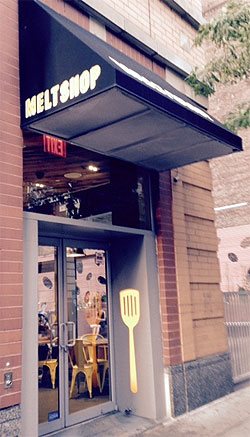
Photo by Jim Hill
Which is this restaurant that only sells grilled cheese sandwiches.
This comfort food was delicious, but kind of on the heavy side.
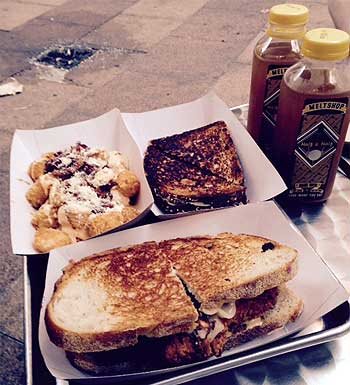
Photo by Jim Hill
Which is why — given that it was a beautiful summer night
— we'd then try and walk off our meals. We started our stroll down by the Empire
State Building
…

Photo by Jim Hill
… and eventually wound up just below Times
Square (right behind where the Waterford Crystal Times Square New
Year's Eve Ball is kept).
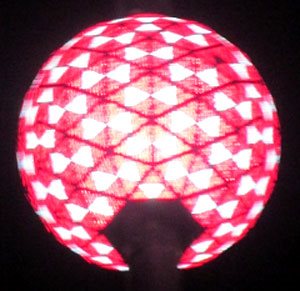
Photo by Jim Hill
But you know what we discovered en route? Right in the heart
of Manhattan's Garment District
along Broadway between 36th and 41st? This incredibly cool series of life-like
and life-sized sculptures that Seward
Johnson has created.
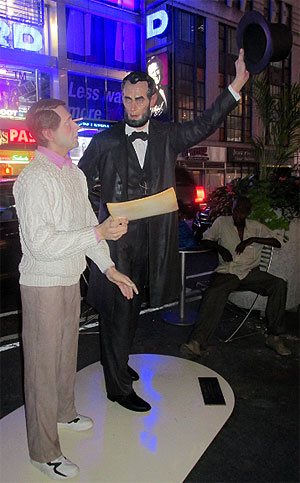
Photo by Jim Hill
And — yes — that is Abraham Lincoln (who seems to have
slipped out of WDW's Hall of Presidents when no one was looking and is now
leading tourists around Times Square). These 18 painted
bronze pieces (which were just installed late this past Sunday night / early
Monday morning) range from the surreal to the all-too-real.
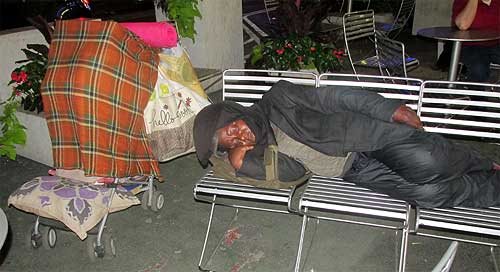
Photo by Jim Hill
Some of these pieces look like typical New Yorkers. Like the
business woman planning out her day …
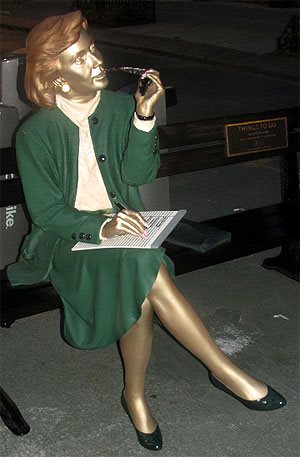
Photo by Jim Hill
… the postman delivering the mail …
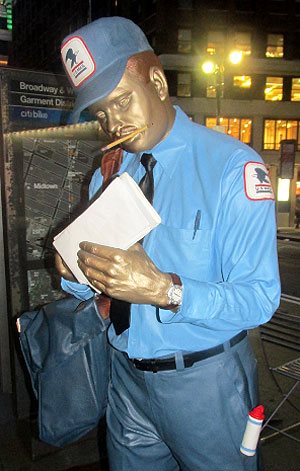
Photo by Jim Hill
… the hot dog vendor working at his cart …
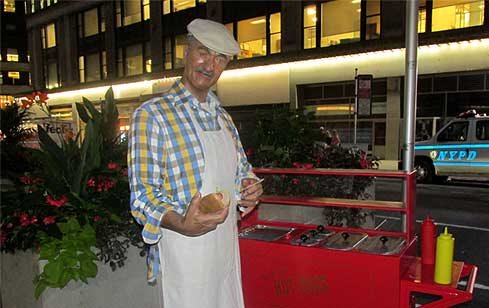
Photo by Jim Hill
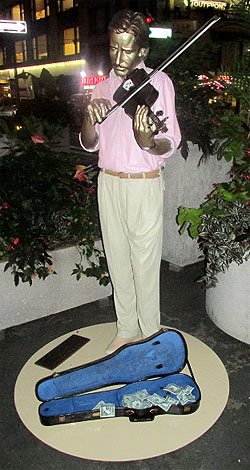
Photo by Jim Hill
… the street musician playing for tourists …
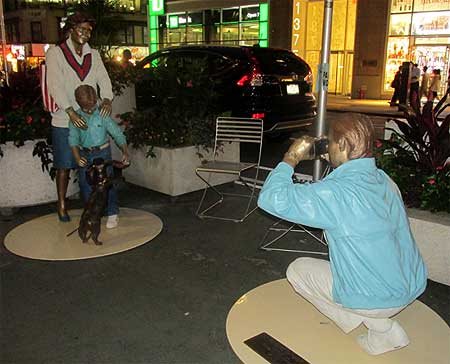
Photo by Jim Hill
Not to mention the tourists themselves.
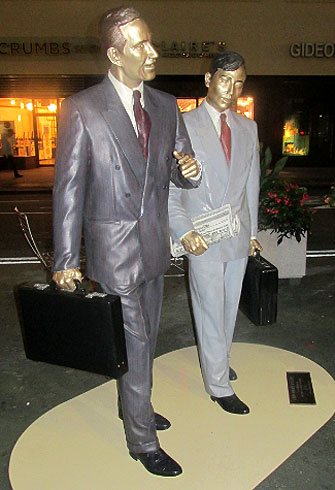
Photo by Jim Hill
But right alongside the bronze businessmen …
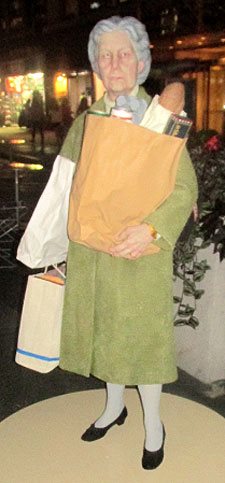
Photo by Jim Hill
… and the tired grandmother hauling her groceries home …
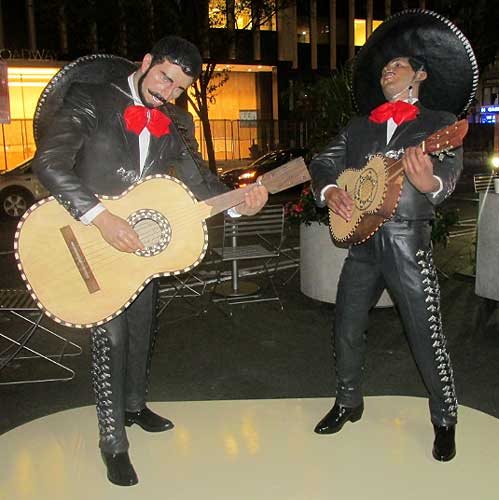
Photo by Jim Hill
… there were also statues representing people who were
from out-of-town …
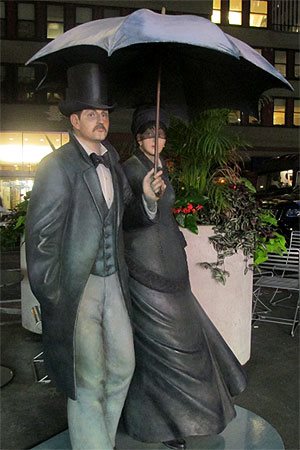
Photo by Jim Hill
… or — for that matter — out-of-time.
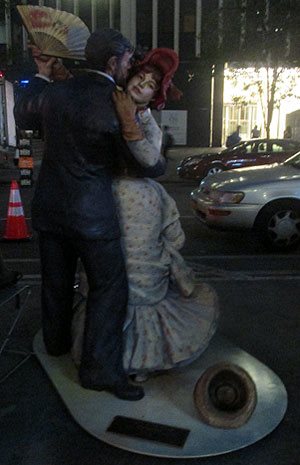
Photo by Jim Hill
These were the Seward Johnson pieces that genuinely beguiled. Famous impressionist paintings brought to life in three dimensions.
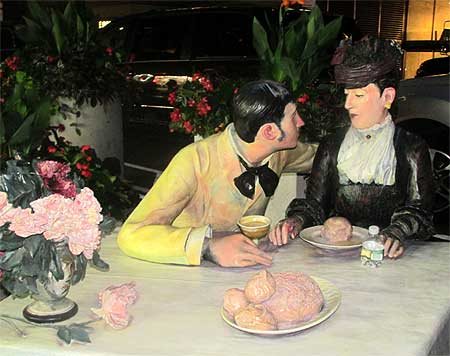
Note the out-of-period water bottle that some tourist left
behind. Photo by Jim Hill
Some of them so lifelike that you actually had to pause for
a moment (especially as day gave way to night in the city) and say to yourself
"Is that one of the bronzes? Or just someone pretending to be one of these
bronzes?"
Mind you, for those of you who aren't big fans of the
impressionists …
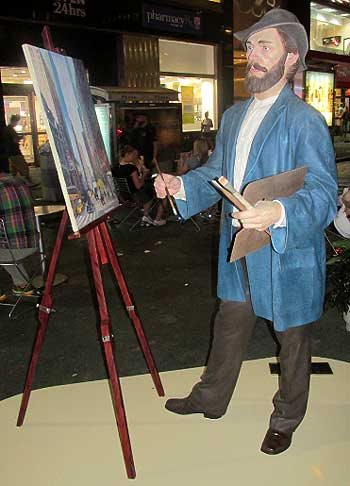
Photo by Jim Hill
… there's also an array of American icons. Among them
Marilyn Monroe …
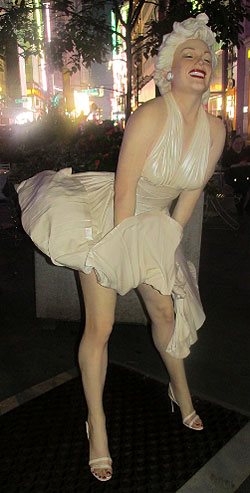
Photo by Jim Hill
… and that farmer couple from Grant Wood's "American
Gothic."
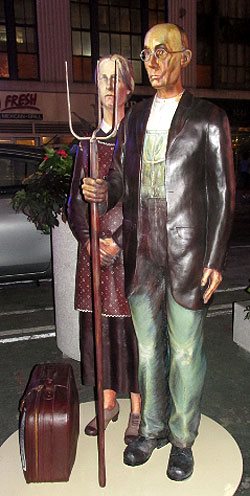
Photo by Jim Hill
But for those of you who know your NYC history, it's hard to
beat that piece which recreates Alfred Eisenstaedt's famous photograph of V-J Day in Times Square.
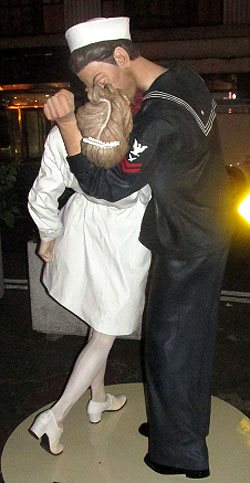
Photo by Jim Hill
By the way, a 25-foot-tall version of this particular Seward
Johnson piece ( which — FYI — is entitled "Embracing Peace") will actually
be placed in Times Square for a few days on or around August 14th to commemorate the 70th
anniversary of Victory Over Japan Day (V-J Day).
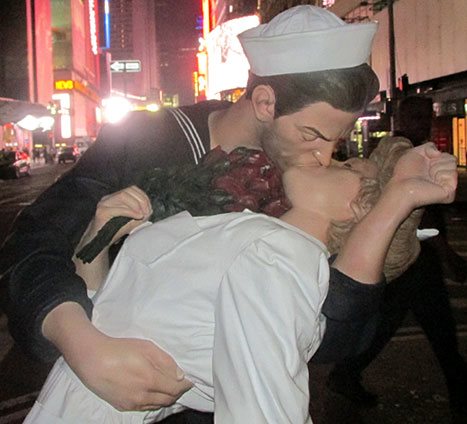
Photo by Jim Hill
By the way, if you'd like to check these Seward Johnson bronzes in
person (which — it should be noted — are part of the part of the Garment
District Alliance's new public art offering) — you'd best schedule a trip to
the City sometime over the next three months. For these pieces will only be on
display now through September 15th.
General
Wondering what you should “Boldly Go” see at the movies next year? The 2015 Licensing Expo offers you some clues

Greeting from the 2015 Licensing Expo, which is being held
at the Mandalay Bay
Convention Center in Las
Vegas.

Photo by Jim Hill
I have to admit that I enjoy covering the Licensing Expo.
Mostly becomes it allows bloggers & entertainment writers like myself to
get a peek over the horizon. Scope out some of the major motion pictures &
TV shows that today's vertically integrated entertainment conglomerates
(Remember when these companies used to be called movie studios?) will be
sending our way over the next two years or so.
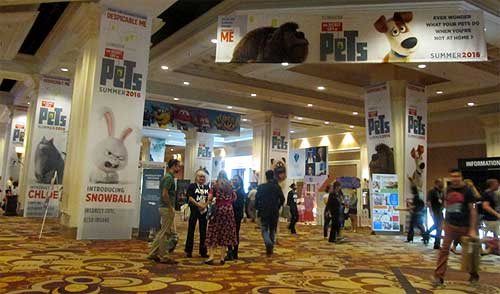
Photo by Jim Hill
Take — for example — all of "The Secret Life of
Pets" banners that greeted Expo attendees as they made their way to the
show floor today. I actually got to see some footage from this new Illumination
Entertainment production (which will hit theaters on July 8, 2016) the last time I was in Vegas. Which
was for CinemaCon back in April. And the five or so minutes of film that I viewed
suggested that "The Secret Life of Pets" will be a really funny
animated feature.
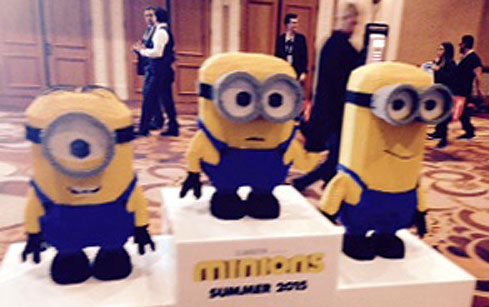
Photo by Jim Hill
Mind you, Universal Pictures wanted to make sure that Expo
attendees remembered that there was another Illumination Entertainment production
coming-to-a-theater-near-them before "The Secret Life of Pets" (And
that's "Minions," the "Despicable Me" prequel. Which
premieres at the Annecy International Animated Film Festival next week but
won't be screened stateside 'til July 10th of this year). Which is why they had
three minions who were made entirely out of LEGOS loitering out in the lobby.
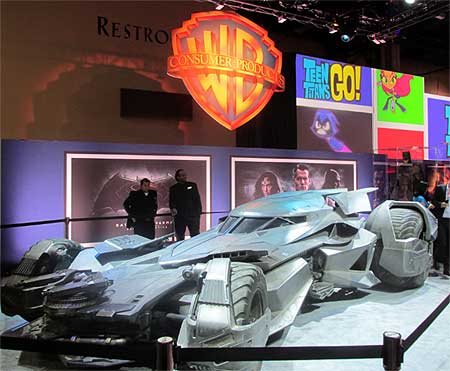
Photo by Jim Hill
And Warner Bros. — because they wanted "Batman v
Superman: Dawn of Justice" to start trending on Twitter today — brought
the Batmobile to Las Vegas.
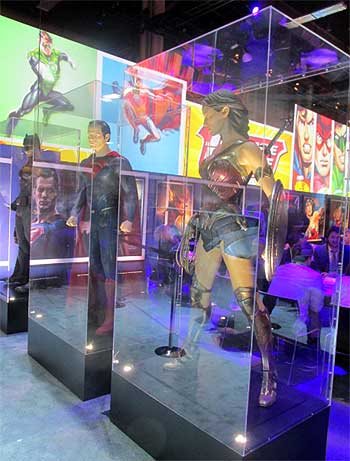
Photo by Jim Hill
Not to mention full-sized macquettes of Batman, Superman and
Wonder Woman. Just so conventioneers could then see what these DC superheroes
would actually look like in this eagerly anticipated, March 25, 2016 release.
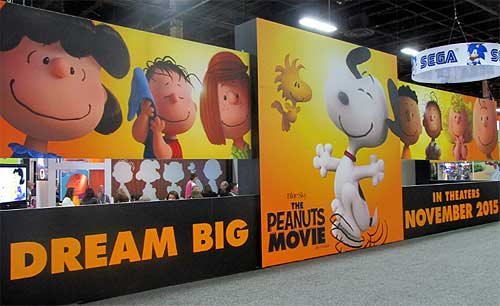
Photo by Jim Hill
That's the thing that can sometimes be a wee bit frustrating
about the Licensing Expo. It's all about delayed gratification. You'll come
around a corner and see this 100 foot-long ad for "The Peanuts Movie"
and think "Hey, that looks great. I want to see that Blue Sky Studios production
right now." It's only then that you notice the fine print and realize that
"The Peanuts Movie" doesn't actually open in theaters 'til November
6th of this year.
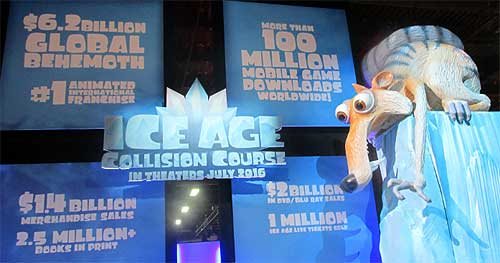
Photo by Jim Hill
And fan of Blue Sky's "Ice Age" film franchise are in for an even
longer wait. Given that the latest installment in that top grossing series
doesn't arrive in theaters 'til July
15, 2016.

Photo by Jim Hill
Of course, if you're one of those people who needs immediate
gratification when it comes to your entertainment, there was stuff like that to
be found at this year's Licensing Expo. Take — for example — how the WWE
booth was actually shaped like a wrestling ring. Which — I'm guessing — meant
that if the executives of World Wrestling Entertainment, Inc. didn't like
the offer that you were making, they were then allowed to toss you out over the
top rope, Royal Rumble-style.
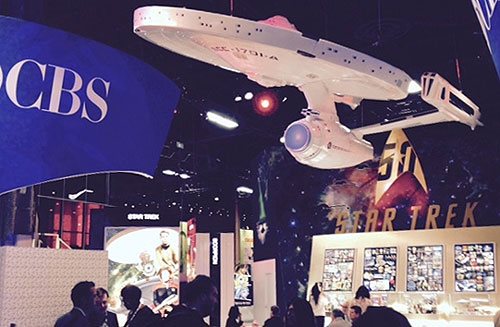
Photo by Jim Hill
I also have to admit that — as a longtime Star Trek fan —
it was cool to see the enormous Starship Enterprise that hung in place over the
CBS booth. Not to mention getting a glimpse of the official Star Trek 50th
Anniversary logo.
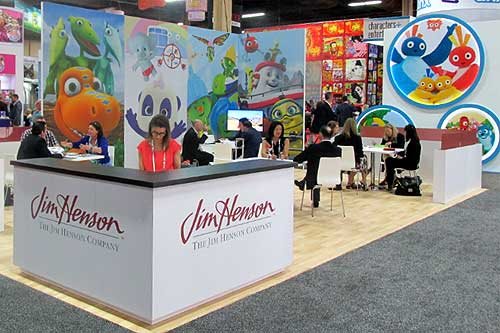
Photo by Jim Hill
I was also pleased to see lots of activity in The Jim Henson
Company booth. Which suggests that JHC has actually finally carved out a
post-Muppets identity for itself.
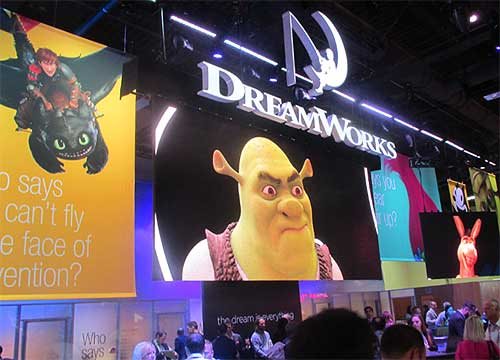
Photo by Jim Hill
Likewise for all of us who were getting a little concerned
about DreamWorks Animation (what with all the layoffs & write-downs &
projects that were put into turnaround or outright cancelled last year), it was
nice to see that booth bustling.
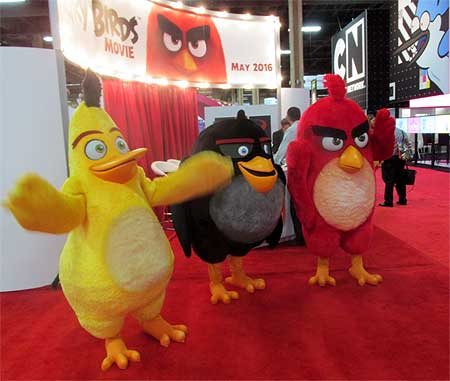
Photo by Jim Hill
Every so often, you'd come across some people who were
promoting a movie that you weren't entirely sure that you actually wanted to
see (EX: "Angry Birds," which Sony Pictures Entertainment / Columbia
Pictures will be releasing to theaters on May 20, 2016). But then you remembered that Clay Kaytis —
who's this hugely talented former Walt Disney Animation Studios animator — is
riding herd on "Angry Birds" with Fergal Reilly. And you'd think
"Well, if Clay's working on 'Angry Birds,' I'm sure this animated feature
will turn out fine."
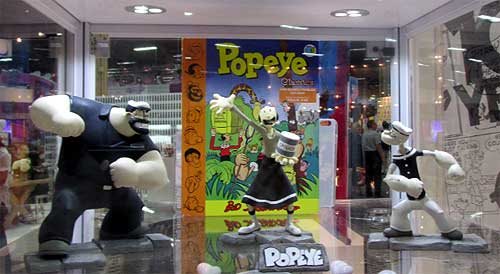
Photo by Jim Hill
Mind you, there were reminders at this year's Licensing Expo
of great animated features that we're never going to get to see now. I still
can't believe — especially after that brilliant proof-of-concept footage
popped up online last year — that Sony execs decided not to go forward
with production of Genndy Tartakovsky's
"Popeye" movie. But that's the
cruel thing about the entertainment business, folks. It will sometime break
your heart.
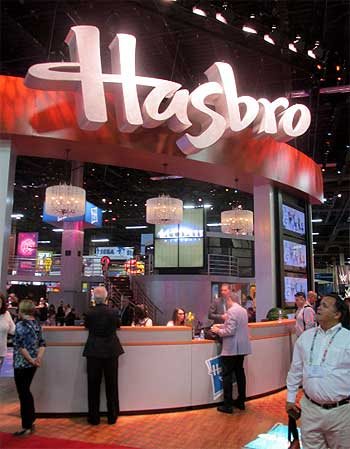
Photo by Jim Hill
And make no mistake about this. The Licensing Expo is all
about business. That point was clearly driven home at this year's show when —
as you walked through the doors of the Mandalay
Bay Convention Center
— the first thing that you saw was the Hasbros Booth. Which was this gleaming,
sleek two story-tall affair full of people who were negotiating deals &
signing contracts for all of the would-be summer blockbusters that have already
announced release dates for 2019 & beyond.
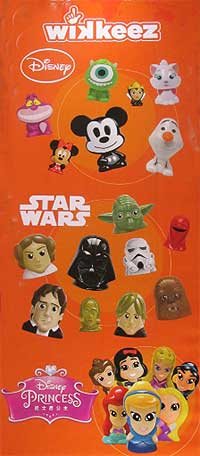
Photo by Jim Hill
"But what about The Walt Disney Company?," you
ask. "Weren't they represented on the show floor at this year's Licensing
Expo?" Not really, not. I mean, sure. There were a few companies there hyping
Disney-related products. Take — for example — the Disney Wikkeez people.
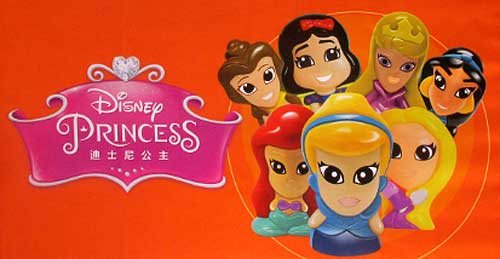
Photo by Jim Hill
I'm assuming that some Disney Consumer Products exec is
hoping that Wikkeez will eventually become the new Tsum Tsum. But to be blunt,
these little hard plastic figures don't seem to have the same huggable charm
that those stackable plush do. But I've been wrong before. So let's see what
happens with Disney Wikkeez once they start showing up on the shelves of the
Company's North American retail partners.
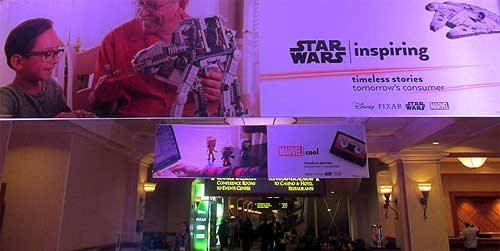
Photo by Jim Hill
And speaking of Disney's retail partners … They were
meeting with Mouse House executives behind closed doors one floor down from the
official show floor for this year's Licensing Expo.

Photo by Jim Hill
And the theme for this year's invitation-only Disney shindig? "Timeless
Stories" involving the Disney, Pixar, Marvel & Lucasfilm brands that
would then appeal to "tomorrow's consumer."
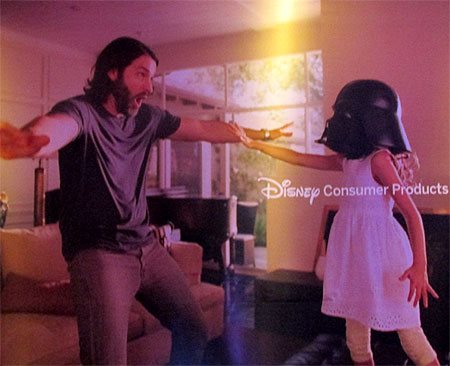
Photo by Jim Hill
And just to sort of hammer home the idea that Disney is no
longer the Company which cornered the market when it comes to little girls
(i.e., its Disney Princess and Disney Fairies franchises), check out this
wall-sized Star Wars-related image that DCP put up just outside of one of its
many private meeting rooms. "See?," this carefully crafted photo
screams. "It isn't just little boys who want to wield the Force. Little
girls also want to grow up and be Lords of the Sith."
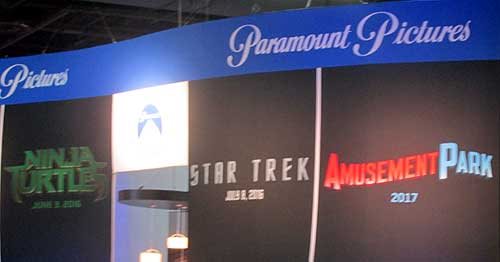
Photo by Jim Hill
One final, kind-of-ironic note: According to this banner,
Paramount Pictures will be releasing a movie called "Amusement Park"
to theaters sometime in 2017.
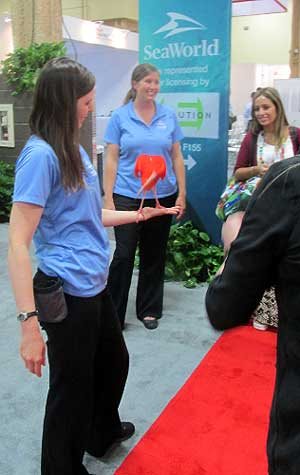
Photo by Jim Hill
Well, given all the "Blackfish" -related issues
that have been dogged SeaWorld Parks & Entertainment over the past two years, I'm
just hoping that they'll still be in the amusement park business come 2017.
Your thoughts?
General
It takes more than three circles to craft a Classic version of Mickey Mouse

You know what Mickey Mouse looks like, right? Little guy,
big ears?
Truth be told, Disney's corporate symbol has a lot of
different looks. If Mickey's interacting with Guests at Disneyland
Park (especially this summer, when
the Happiest Place on Earth
is celebrating its 60th anniversary), he looks & dresses like this.
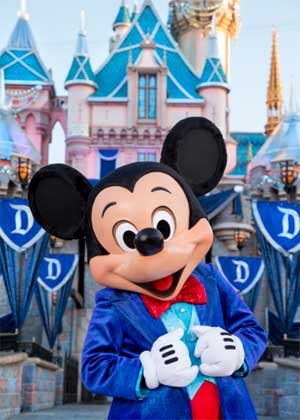
Copyright Disney Enterprises,
Inc.
All rights reserved
Or when he's appearing in one of those Emmy Award-winning shorts that Disney
Television Animation has produced (EX: "Bronco Busted," which debuts
on the Disney Channel tonight at 8 p.m. ET / PT), Mickey is drawn in a such a
way that he looks hip, cool, edgy & retro all at the same time.
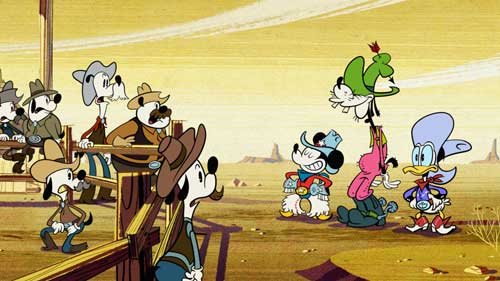
Copyright Disney Enterprises, Inc. All rights
reserved
Looking ahead to 2017 now, when Disney Junior rolls out "Mickey and the
Roadster Racers," this brand-new animated series will feature a sportier version
of Disney's corporate symbol. One that Mouse House managers hope will persuade
preschool boys to more fully embrace this now 86 year-old character.
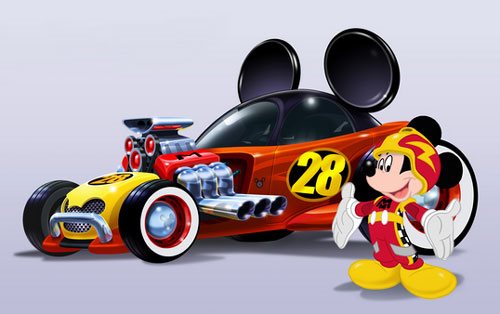
Copyright Disney Enterprises,
Inc. All rights reserved
That's what most people don't realize about the Mouse. The
Walt Disney Company deliberately tailors Mickey's look, even his style of
movement, depending on what sort of project / production he's appearing in.
Take — for example — Disney
California Adventure
Park's "World of Color:
Celebrate!" Because Disney's main mouse would be co-hosting this new
nighttime lagoon show with ace emcee Neil Patrick Harris, Eric Goldberg really had
to step up Mickey's game. Which is why this master Disney animator created
several minutes of all-new Mouse animation which then showed that Mickey was
just as skilled a showman as Neil was.

Copyright Disney Enterprises,
Inc.
All rights reserved
Better yet, let's take a look at what the folks at Avalanche Studios just went
through as they attempted to create a Classic version of Mickey & Minnie.
One that would then allow this popular pair to become part of Disney Infinity
3.0.
"I won't lie to you. We were under a lot of pressure to
get the look of this particular version of Mickey — he's called Red Pants
Mickey around here — just right," said Jeff Bunker, the VP of Art
Development at Avalanche Studios, during a recent phone interview. "When
we brought Sorcerer Mickey into Disney Infinity 1.0 back in January of 2014,
that one was relatively easy because … Well, everyone knows what Mickey Mouse
looked like when he appeared in 'Fantasia.' "
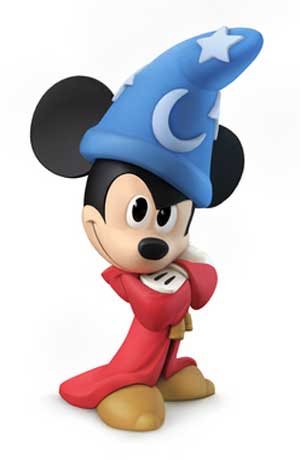
Copyright Disney Enterprises,
Inc. All rights reserved
"But this time around, we were being asked to design
THE Mickey & Minnie," Bunker continued. "And given that these Classic
Disney characters have been around in various different forms for the better
part of the last century … Well, which look was the right look?"
Which is why Jeff and his team at Avalanche Studios began watching hours &
hours of Mickey Mouse shorts. As they tried to get a handle on which look would
work best for these characters in Disney Infinity 3.0.
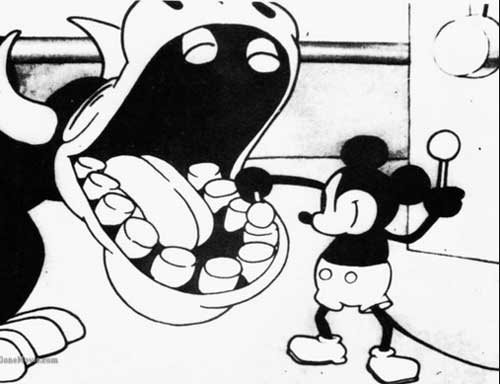
Copyright Disney
Enterprises, Inc. All rights reserved
"And we went all the way back to the very start of Mickey's career. We began
with 'Steamboat Willie' and then watched all of those black & white Mickey shorts
that Walt made back in the late 1920s & early 1930s. From there, we
transitioned to his Technicolor shorts. Which is when Mickey went from being
this pie-eyed, really feisty character to more of a well-behaved leading
man," Bunker recalled. "We then finished out our Mouse marathon by
watching all of those new Mickey shorts that Paul Rudish & his team have
been creating for Disney Television Animation. Those cartoons really recapture
a lot of the spirit and wild slapstick fun that Mickey's early, black &
white shorts had."
But given that the specific assignment that Avalanche Studios had been handed
was to create the most appealing looking, likeable version of Mickey Mouse
possible … In the end, Jeff and his team wound up borrowing bits & pieces
from a lot of different versions of the world's most famous mouse. So that
Classic Mickey would then look & move in a way that best fit the sort of
gameplay which people would soon be able to experience with Disney Infinity
3.0.
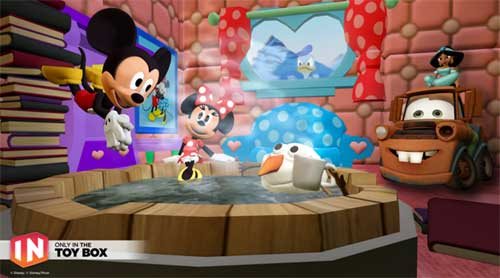
Copyright Disney Enterprises,
Inc. All rights reserved
"That — in a lot of ways — was actually the toughest
part of the Classic Mickey design project. You have to remember that one of the
key creative conceits of Disney Infinity
is that all the characters which appear in this game are toys," Bunker
stated. "Okay. So they're beautifully detailed, highly stylized toy
versions of beloved Disney, Pixar, Marvel & Lucasfilm characters. But
they're still supposed to be toys. So our Classic versions of Mickey &
Minnie have the same sort of thickness & sturdiness to them that toys have.
So that they'll then be able to fit right in with all of the rest of the
characters that Avalanche Studios had previously designed for Disney Infinity."
And then there was the matter of coming up with just the
right pose for Classic Mickey & Minnie. Which — to hear Jeff tell the
story — involved input from a lot of Disney upper management.
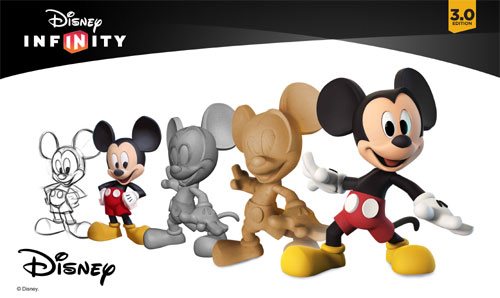
Copyright Disney Enterprises,
Inc. All rights reserved
"Everyone within the Company seemed to have an opinion
about how Mickey & Minnie should be posed. More to the point, if you Google
Mickey, you then discover that there are literally thousands of poses out there
for these two. Though — truth be told — a lot of those kind of play off the
way Mickey poses when he's being Disney's corporate symbol," Bunker said.
"But what I was most concerned about was that Mickey's pose had to work
with Minnie's pose. Because we were bringing the Classic versions of these
characters up into Disney Infinity 3.0 at the exact same time. And we wanted to
make sure — especially for those fans who like to put their Disney Infinity
figures on display — that Mickey's pose would then complement Minnie.
Which is why Jeff & the crew at Avalanche Studios
decided — when it came to Classic Mickey & Minnie's pose — that they
should go all the way back to the beginning. Which is why these two Disney icons
are sculpted in such a way that it almost seems as though you're witnessing the
very first time Mickey set eyes on Minnie.
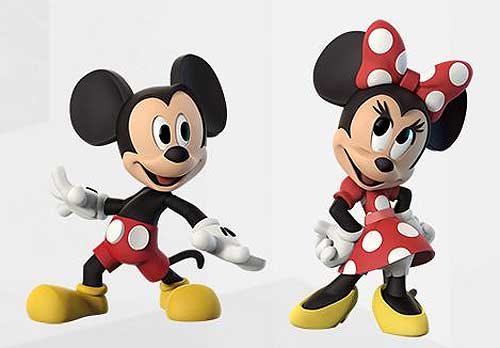
Copyright Disney Enterprises,
Inc. All rights reserved
"And what was really great about that was — as soon as
we began showing people within the Company this pose — everyone at Disney
quickly got on board with the idea. I mean, the Classic Mickey that we sculpted
for Disney Infinity 3.0 is clearly a very playful, spunky character. But at the
same time, he's obviously got eyes for Minnie," Bunker concluded. "So
in the end, we were able to come up with Classic versions of these characters
that will work well within the creative confines of Disney Infinity 3.0 but at
the same time please those Disney fans who just collect these figures because
they like the way the Disney Infinity characters look."
So now that this particular design project is over, does
Jeff regret that Mouse House upper management was so hands-on when it came to
making sure that the Classic versions of Mickey & Minnie were specifically
tailored to fit the look & style of gameplay found in Disney Infinity 3.0?

Copyright Lucasfilm / Disney
Enterprises, Inc. All rights reserved
"To be blunt, we go through this every time we add a new character to the
game. The folks at Lucasfilm were just as hands-on when we were designing the
versions of Darth Vader and Yoda that will also soon be appearing in Disney
Infinity 3.0," Bunker laughed. "So in the end, if the character's
creators AND the fans are happy, then I'm happy."
This article was originally posted on the Huffington Post's Entertainment page on Tuesday, June 9, 2015
-

 News & Press Releases11 months ago
News & Press Releases11 months agoDisney Will Bring D23: The Ultimate Disney Fan Event to Anaheim, California in August 2024
-

 History6 months ago
History6 months agoFrom Birthday Wishes to Toontown Dreams: How Toontown Came to Be
-

 History6 months ago
History6 months agoUnpacking the History of the Pixar Place Hotel
-

 History6 months ago
History6 months agoThe Evolution and History of Mickey’s ToonTown
-

 News & Press Releases5 months ago
News & Press Releases5 months agoNew Updates and Exclusive Content from Jim Hill Media: Disney, Universal, and More
-
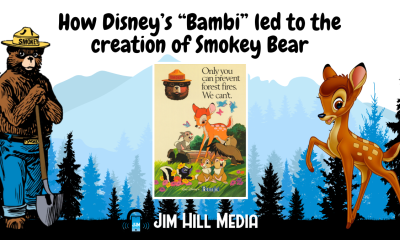
 Film & Movies3 months ago
Film & Movies3 months agoHow Disney’s “Bambi” led to the creation of Smokey Bear
-

 Merchandise4 months ago
Merchandise4 months agoIntroducing “I Want That Too” – The Ultimate Disney Merchandise Podcast






